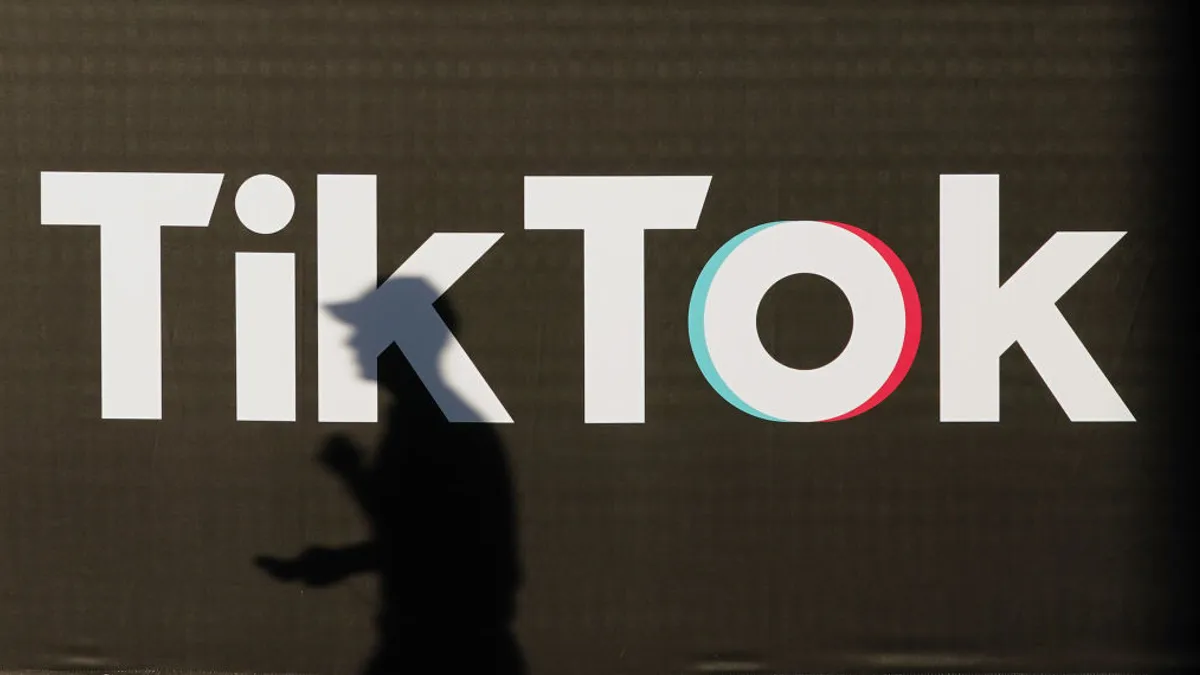Dive Brief:
- The number of consumers exposed to ads on TikTok nearly doubled from 19% last year to 37% this year as the video-sharing app saw skyrocketing popularity, according to findings from Kantar's second annual Media Reactions survey of marketers and consumers about their perceptions of different media brands and channels.
- As with last year, ByteDance's video-sharing platform was viewed as delivering the most "fun and entertaining ads" by consumers, though more users are starting to experience feelings of overload. TikTok also "comfortably" secured a spot as the most innovative place for ads among marketers and saw trust levels with the group double, though it still lags behind more established competitors like YouTube, Google and Facebook, which are seen as more trustworthy but less innovative.
- Kantar found that many formats that previously proved less popular with consumers are starting to better ingratiate themselves, including online and mobile gaming ads and ads on music streaming services. Those gains were attributed to greater exposure due to the pandemic, which has spurred a radical shift to digital media.
Dive Insight:
Kantar's latest Media Reactions report suggests the accelerated adoption of digital channels over the past year-plus has strengthened consumer perceptions and comfort with ads running in those environments. The findings note that consumer trust in platforms often preempts that of marketers, a group that tends to be more conservative in trying to strike a balance between brand safety and innovation while juggling media budgets. More than 900 marketing professionals and 14,500 consumers across 23 markets were polled for the research, and Kantar claims the results are representative of about 80% of global media spend.
Unsurprisingly, TikTok was seen as a leading hub for innovation and entertainment on both sides of the aisle in 2021. The video-sharing app, after weathering a controversy over a potential ban in the U.S. last year, has continued to attract users in droves, and recently became the first non-Facebook mobile app to surpass 3 billion downloads. Consumers ranked Amazon — a newcomer to the ranking — No. 2 on ad receptiveness, followed by Instagram, Google and Twitter.
While marketer trust in TikTok is still not at the levels of more established social media platforms, it has made "enormous improvements," per Kantar. The continued introduction of new products in desirable areas like social commerce and creator content could further boost the Gen Z favorite in the months ahead.
Other channels that felt less proven in the pre-pandemic world are starting to win over consumers and brands. Online and mobile gaming ads remained the least popular channel with consumers, but saw a 5% year-on-year increase in ad equity, or receptiveness, measurement — the largest gains among the 22 channels Kantar tracked. Music streaming ads, podcast ads and ads on streaming services helped round out the most-improved online channels, each securing a 3% YoY jump in consumer ad equity. Ads running around social media stories saw a 1% YoY gain.
Podcasts, in general, became a more formidable category in 2021, overtaking influencer marketing as the No. 1 online media channel for ad equity after landing in second place in 2020. Consumers think podcast ads are improving on the quality and relevance fronts, though, similar to TikTok, repetitiveness was cited as a bigger problem. Platforms like Spotify and Amazon have invested heavily in acquiring more podcast content and ad technology in the race to engage listeners, though Kantar cautioned that the space could become overcrowded.
"Marketers increased investment in podcasts in 2021 and will continue to invest more in 2022, accelerating the digital transformation of audio, as planned spend on radio continues to decrease," Kantar said. "Podcast publishers need to keep saturation at bay to avoid killing this golden digital goose."
Even as nascent formats felt fresh tailwinds, marketers continued to show a preference for old favorites. Instagram managed the best balancing act between trust and innovation, Kantar found. Notably, influencer marketing climbed to the No. 3 most-trusted media spot among marketers, a significant jump from 10th place last year. The forward momentum, which puts influencers behind only TV and online video in marketers' eyes, could be a sign of the category reaching new levels of maturity despite ongoing risks when it comes to managing talent.
"Marketers' high level of trust in influencers probably reflects a genuine desire for a new type of conversation with consumers and greater comfort with the idea of giving up some elements of control of their brand messaging," Kantar said. "It may also reflect the efforts of the influencer industry to 'grow up,' with increased regulation, a new breed of agencies and more orderly systems and processes for the creation, scaling and measurement of influencer campaigns."














